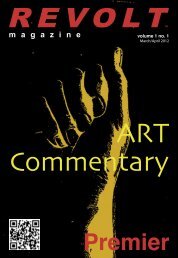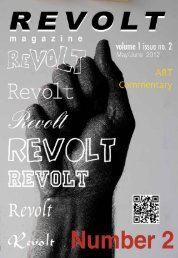Download PDF Version Revolt Magazine, Volume 1 Issue No.4
Download PDF Version Revolt Magazine, Volume 1 Issue No.4
Download PDF Version Revolt Magazine, Volume 1 Issue No.4
You also want an ePaper? Increase the reach of your titles
YUMPU automatically turns print PDFs into web optimized ePapers that Google loves.
of “performative queerness.” Do you see any<br />
relationship between your work and hers? How<br />
do you situate yourself as a female architect/<br />
artist in relationship to the larger structures<br />
and institutions in which your work intervenes?<br />
aesthetic that you’re working with in a different context<br />
too, you weren’t trying to build the next Guggenheim.<br />
in Iceland for almost 5 years before moving to New<br />
York. Now I am working between these two places.<br />
There’s something about the dynamics of changing<br />
TH: I don’t really know that I relate to her, although<br />
she’s someone that I respect immensely. I know<br />
little of her relationship with Le Corbusier but<br />
there’s definitely a whole issue around the female<br />
architect. The contemporary landscape of superstar<br />
architects is predominantly male. But then again<br />
that might not be the most interesting place to<br />
be. I recently heard an interview with a Danish<br />
modernist architect Knud Holscher. He spent a big<br />
part of his career doing public projects and some<br />
product design for example toilet seats of which he<br />
spoke with dignity and pride. When he was asked<br />
which project he would have loved to do during his<br />
career, he answered that he had always wanted<br />
to design public housing. That I respect deeply.<br />
Much of the contemporary architecture we see in<br />
glossy magazines is so much about ego and capital.<br />
Obviously there are amazing female architects and<br />
practitioners, but in the dominant media, they tend<br />
to still stand in the background. Perhaps except Zaha<br />
Hadid and Kazuyo Sejima. When I tell people that I am<br />
also trained as an architect, often I am met with “Oh<br />
so do you do interiors?” as if it is difficult to imagine<br />
a woman being a building designer and easier to<br />
connect her to the realm of the (domestic) interior.<br />
I think it’s super problematic that there’s these<br />
gendered relationships in practices, but I don’t know<br />
that my work relates to this whole aspect directly. I<br />
think that in certain ways a queer / feminist reading<br />
of some of my work has occurred mostly in terms of<br />
the three installations in Iceland. One reading has<br />
been that it’s a feminist gesture or insertion of a<br />
feminine presence in urban space. Someone has<br />
also made a queer drag reading, saying it was like<br />
a building in drag. I think that’s super interesting<br />
and I really enjoy these readings and how they can<br />
expand the project. I’m interested in thinking along<br />
the lines of - is the project within the boundary of<br />
this physical object or does the boundary extend<br />
to where the readings start and end? Meanwhile<br />
these ideas are not something that, at least on<br />
a conscious level, I have charged the work with.<br />
KC: What stands out to me about your work<br />
is that you marry what I’d term a hard-edged<br />
European conceptualism with healthy doses<br />
of imagination and whimsy, where does this<br />
come from? What artists are you looking at?<br />
TH: This is a really old school and male reference<br />
but I’m definitely looking at Dan Graham and Gordon<br />
Matta-Clark. Obviously if you come out of architecture<br />
then it’s really hard to not look at Matta-Clark with<br />
great respect. I think his work is really about taking<br />
architecture out of the boundaries of functionality and<br />
all these kind of modernist tropes that architecture<br />
proper has to deal with. More viewing architecture<br />
as a kind of semiotic system, which is very much<br />
at the basis of my practice. Others I look to with<br />
admiration are for example Matthew Buckingham,<br />
Chantal Ackerman and Rachel Whiteread.<br />
KC: One thing that you said earlier was that you<br />
originally wanted to do set design which puts the<br />
REVOLT<br />
<strong>Magazine</strong> Number 4, 2013<br />
Parallel Memories (2013), installation view, "There's No Place LIke Home", Westfälischer Kunstverein, Münster, Germany.<br />
Photo credit T. Arendt.<br />
TH: I think that’s interesting in terms of the relationship<br />
between art and architecture. My relationship to<br />
temporality is very different, a different relationship<br />
to monumental permanence. The whole process<br />
of drawing an architectural work and then building<br />
it is an incredibly long process. I’m interested in a<br />
kind of temporariness. The first of the installations<br />
in Reykjavík has lasted now since 2006. In the wake<br />
of the last winter, the hurricane recently on the east<br />
coast came by Iceland as well, the very last sequins<br />
blew off two of the pieces. Now they’re these naked<br />
structures left in the urban space, which sparked<br />
a whole consideration about what to do with them<br />
and could they be restored. After a long process I<br />
have decided to take them down. It seems like a<br />
very right and natural thing to do because they were<br />
so much born out of a certain moment in Icelandic<br />
time, the years leading up to and following the big<br />
global economic crash that was specifically violent<br />
in Iceland and the several years of excess that led up<br />
to it. Also the sort of commodification of everything<br />
that could be commodified in nature, which was<br />
what these projects were about. Because they’re<br />
so specific to this moment in a sort of a geographic<br />
time of Iceland as a culture and also a specific<br />
time in my personal development it just feels that<br />
it’s right to take them down. Even the material has<br />
a natural time. So, great that the last sequins are<br />
gone, it’s fine. Not everything has to last forever.<br />
KC: I understand you’re quite the nomad<br />
these days. What is your relationship to<br />
notions of the local, homeplace, nation and<br />
territory and how do these shape your work?<br />
TH: These aspects of place and belonging and relating<br />
to a place are really at the basis of my practice. I<br />
have very strong relationships to 4 very different<br />
places, of course they are all western cultures so<br />
they are not so radically different but each has its<br />
own specific logic. I’m half Czech and half Danish<br />
so I have very special relationships to both these<br />
places. I grew up going back and forth over the iron<br />
curtain traveling to Czechoslovakia as it was called<br />
formerly and Denmark where I’m born. Then I lived<br />
place and changing the situation from being inside<br />
and part of a situation to looking at the same place<br />
from the outside, which I think opens a possibility<br />
for a more a critical distance. I just finished a<br />
new video work called Parallel Memories, that is<br />
partially about that. It’s about returning to the site<br />
of an inherited trauma, tracing the structures of<br />
real places with the psychological structures of the<br />
memory of a place. This is a project that I started at<br />
the Whitney Program and it is currently on view at<br />
a group exhibition in Germany at the Westfälischer<br />
Kunstverein. The exhibition is actually called<br />
“There’s No Place like Home.” When I was doing the<br />
project in Russia I accidentally met a Russian guy<br />
around my age who had grown up in Czechoslovakia<br />
as the son of a Russian soldier who was part of<br />
the occupying forces. My history is informed by my<br />
mother immigrating to Denmark in 1968 before<br />
the borders closed. There was something about<br />
the tension between these two subject positions<br />
– this became the framework of the project. They<br />
seemed as if they couldn’t be further apart but at<br />
the same time these two stories overlap within a<br />
kind of common space of childhood and a common<br />
experience of a geographic and cultural place<br />
embedded in a specific time. The video is becoming<br />
quite structural in that sense. I’m filming through<br />
an architectural maquette and trying to see if the<br />
structure of shared space and memory is aligned<br />
with or just framing the reality of now. - So there’s<br />
always both an exterior and an interior, - always<br />
this kind of parallactic dynamics of spectatorship.<br />
KC: Is he a subject in the video?<br />
TH: There’s not a dialogue but there’s a voiceover<br />
which is two voices, his voice and mine. The video<br />
is a documentation of me going back to some of<br />
the places I remember myself and also retracing<br />
some of the places that he is talking about. There<br />
are sites that I have never been to within this<br />
former Russian base that is outside of Prague. I<br />
tried to put myself into another subject position.<br />
There’s a blending of the boundaries of subjectivity.<br />
38





